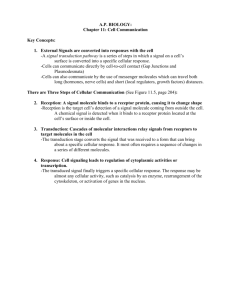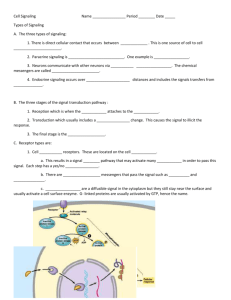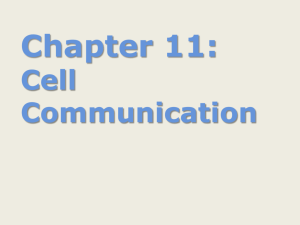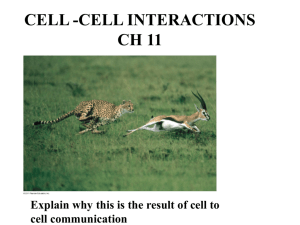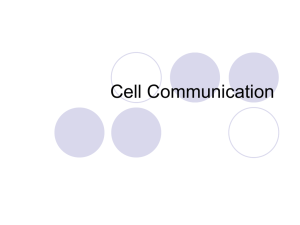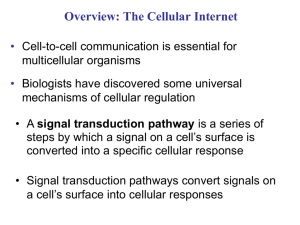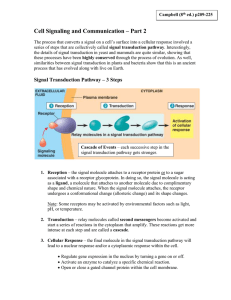Cell Signaling
advertisement
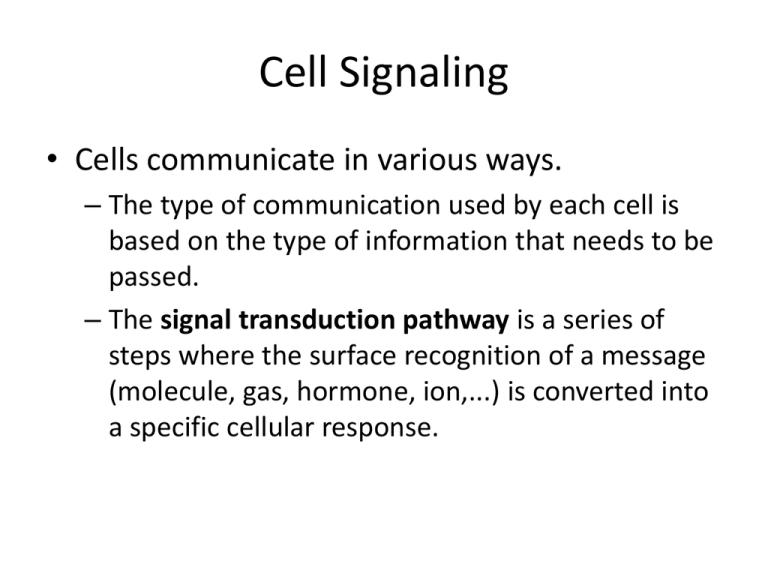
Cell Signaling • Cells communicate in various ways. – The type of communication used by each cell is based on the type of information that needs to be passed. – The signal transduction pathway is a series of steps where the surface recognition of a message (molecule, gas, hormone, ion,...) is converted into a specific cellular response. Examples of cell to cell signaling • Cell junctions - allow molecules to pass freely between cells – animal - Gap – plants - Plasmodesmata • Paracrine signaling - messenger molecules – secreted by signaling cell – short distance – growth factors • Synaptic signaling - vesicles – electrical signal triggers vesicle formation – vesicle fuses with nearby cell releasing the neurotransmitter • Endocrine signaling - hormones – long distance – dumped into the blood stream for widespread delivery 3 Basic Steps • Reception • Transduction • Response Reception – cell signal (ligand) binds to a surface receptor on the outside (or inside) of the cell – large molecules and hydrophilic molecules must bind to a surface receptor (3-types) • G-proteins - associated with GTP – protein receptor binds ligand & causes a change in G-protein from GDP to GTP – activated complex travels to an enzyme (still in the membrane) and activates it causing a cellular response in the cytosol – Some signal molecules are not proteins but are considered "secondary messangers" » cAMP is the secondary messenger of a G-protein Reception • Tyrosine Kinases – transmembrane proteins have binding sites and multiple tyrosine (Tyr) sites in the cytosol – protein receptor binds the ligands and causes 2 complexes to move together – the phosphorylation of the active Tyr by ATP » the active sites then activate relay proteins to cause a cellular response » 1 tyrosine kinase may activate up to ten different processes Reception • Ligand-gated Ion channels – binding of the ligand causes a conformation change and opening of a gate to ions of a specific charge • hydrophobic molecules (steroids) and small molecules (NO) can pass directly through the plasma membrane to bind with receptors in the cytosol Transduction • after binding the surface protein changes to a form that brings about cellular change – change may be in the cytoplasm or in the nucleus – involves the change in inactive compounds to their active conformations – efficiency may be increased by the presence of scaffolding proteins • protein complex with multiple relay protein receptor sites that carry out a cascade of reactions Response • cellular change brought about by the transduction of the signal • involves signal amplification – activated complex during transduction may activate many molecules before becoming inactive again • all different cells are specific in their response – they all have differing amounts and types of protein complexes and receptors • inactivation of the receptor occurs as the product is produced and the molecule departs from its receptor
